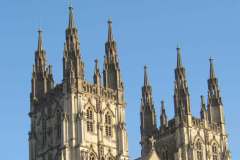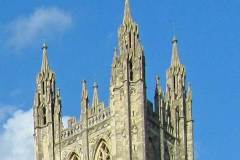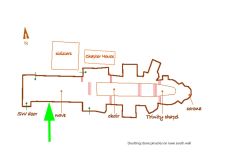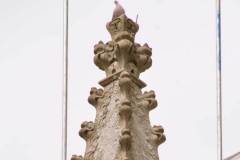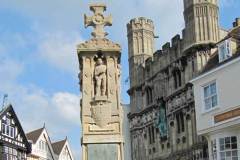Basics
Geology: coarse crystalline limestone
Rock unit: Inferior Oolite Group
Age: Middle Jurassic
Provenance: Doulting, Somerset
Where to see examples
There are no blocks of Doulting Stone known to the author at ground level – more below.
The War Memorial in the Buttermarket, outside the Christ Church Gate, was carved from Doulting Stone.
Description
A Jurassic limestone quarried from near Shepton Mallet south of the Mendips in Somerset. The stone is pale-brown to dark-brown in colour and after prolonged exposure weathers to a uniform grey. It has been worked since the twelfth century and was used as the major building stone for Wells Cathedral. From medieval times the quarries were rarely found to supply a uniform product. Some beds were oolitic while others provided a coarse, granular stone. During much of the twentieth century the beds yielded a fragmental limestone composed of older re-worked limestones that were deposited in fairly shallow Jurassic seas. This stone has a coarsely crystalline texture containing various fossil fragments, including crinoids (sea lilies); all bound in a calcite cement.
Shortly before the First World War The Ham Hill and Doulting Stone Company supplied stone to the cathedral and orders placed by the Chapter’s agent frequently sought the “hard grey Doulting stone of the Chilynch Bed [also known as the Chelynch Bed]”. This coarse-grained stone, also known as the ‘weathering bed’, was especially favoured when replacing stones exposed to the elements. William Caröe had used Doulting Stone previously at Canterbury when he repaired the Bell Harry pinnacles between 1903 and 1908 and again in 1912 when he repaired the pinnacles of the north and south nave aisles having encountered an early nineteenth century restoration executed in an “inartistic and perfunctory manner”.
However, during late twentieth century inspections, Doulting Stone was found to be weathering preferentially along bedding planes resulting in a tendency to split horizontally. This alternation of hard and soft beds was not common in the stone used in the past and much medieval work on other buildings has survived in very good condition. At Canterbury it was understood that the number and size of the pore spaces allowed water to readily migrate through the stone and a form of granular disintegration took place as the cement matrix dissolved. Decay was then accelerated by frost action and the stone slowly lost all cohesion and finally crumbled away.
In a stonework consultation report prepared in 1990 for Canterbury Cathedral, the authors described Doulting Stone as “an unfortunate choice as not only did it deteriorate but it was a visual disaster weathering to a dead cement-like colour and texture.” The Surveyor of the Fabric, John Burton, stated in 2000 in an article on the restoration of the Candle Tower:
“In my experience, the coarse bed of Doulting stone weathers very well, even in coastal districts. Unfortunately, for some reason Doulting always seems to fail at Canterbury. Before work started on replacing the Doulting pinnacles, one could rub one’s hand over them and the surface would brush away, as there was nothing binding together the small fragments, which make up this limestone. The surface was so badly eroded that large sections were breaking away, particularly under frosty conditions, and falling to the ground. The continuous shedding of stone dust was also blocking gutters and drainpipes.”
The troubled history of Doulting Stone at the higher levels of the cathedral fabric make it difficult to point to specific examples, particularly as some has since weathered badly and been replaced. As mentioned above, it was apparently used by William Caröe (and his son) for repairs to the SW tower (1912) (image 1 below) , to the Bell Harry pinnacles (1903-1908, image 2 below), and to the nave aisle pinnacles (in 1912, images 3 and 4). There is also evidence of use of the stone in the Candle Tower and in the Arundel Tower where it replaced decayed Caen Stone. For a nearby example of Doulting Stone that is more certain and more accessible see the War Memorial (image 5) that stands immediately outside the Christ Church gate.Note the faces (animal and human) at the base of the pinnacle.
Click on the images below to enlarge and read captions. When you expand image 4 note the faces (animal and human) at the base of the pinnacle.

